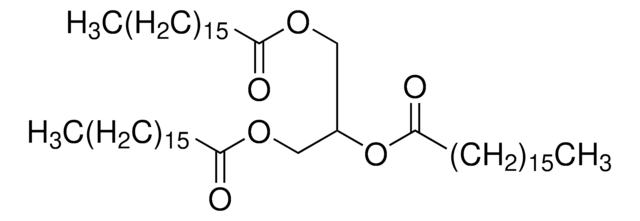S6389
1-Stearoyl-2-arachidonoyl-sn-glycerin
~98%, suitable for stimulation of protein kinase C derived from liver cells, liquid
Synonym(e):
2-Arachidonoyl-1-stearoyl-sn-glycerin
About This Item
Empfohlene Produkte
Assay
~98%
Form
liquid
Verunreinigungen
1,3-isomer, trace
Löslichkeit
chloroform: 20 mg/ml
Eignung
suitable for stimulation of protein kinase C derived from liver cells
Versandbedingung
dry ice
Lagertemp.
−20°C
SMILES String
CCCCCCCCCCCCCCCCCC(=O)OCC(CO)OC(=O)CCC\C=C/C\C=C/C\C=C/C\C=C/CCCCC
InChI
1S/C41H72O5/c1-3-5-7-9-11-13-15-17-19-20-22-24-26-28-30-32-34-36-41(44)46-39(37-42)38-45-40(43)35-33-31-29-27-25-23-21-18-16-14-12-10-8-6-4-2/h11,13,17,19,22,24,28,30,39,42H,3-10,12,14-16,18,20-21,23,25-27,29,31-38H2,1-2H3/b13-11-,19-17-,24-22-,30-28-
InChIKey
NSXLMTYRMFVYNT-LGHBDAFPSA-N
Suchen Sie nach ähnlichen Produkten? Aufrufen Leitfaden zum Produktvergleich
Anwendung
Biochem./physiol. Wirkung
Verpackung
Vorsicht
Lagerklassenschlüssel
10 - Combustible liquids
WGK
WGK 3
Flammpunkt (°F)
Not applicable
Flammpunkt (°C)
Not applicable
Persönliche Schutzausrüstung
Eyeshields, Gloves, multi-purpose combination respirator cartridge (US)
Analysenzertifikate (COA)
Suchen Sie nach Analysenzertifikate (COA), indem Sie die Lot-/Chargennummer des Produkts eingeben. Lot- und Chargennummern sind auf dem Produktetikett hinter den Wörtern ‘Lot’ oder ‘Batch’ (Lot oder Charge) zu finden.
Besitzen Sie dieses Produkt bereits?
In der Dokumentenbibliothek finden Sie die Dokumentation zu den Produkten, die Sie kürzlich erworben haben.
Kunden haben sich ebenfalls angesehen
Unser Team von Wissenschaftlern verfügt über Erfahrung in allen Forschungsbereichen einschließlich Life Science, Materialwissenschaften, chemischer Synthese, Chromatographie, Analytik und vielen mehr..
Setzen Sie sich mit dem technischen Dienst in Verbindung.

















